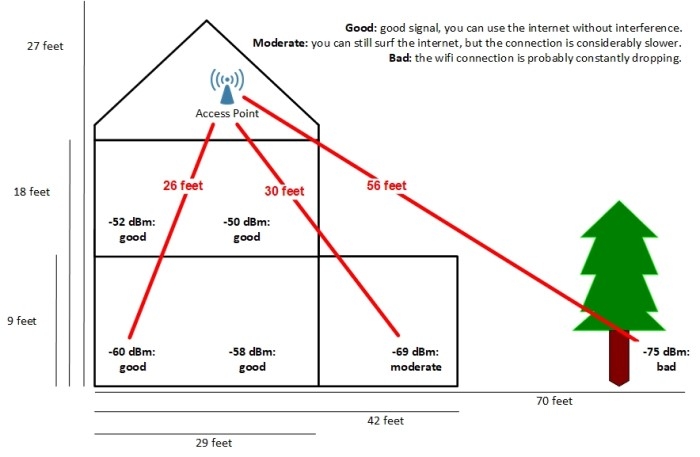What Is The Maximum Range Of Wi-Fi?
Wi-Fi is a wireless technology that allows electronic devices to connect to a network, such as the internet, without the need for wires. Wi-Fi is commonly used in homes, businesses, and public places to provide access to the internet. The maximum range of Wi-Fi is determined by the type of antenna used and the type of Wi-Fi network. Generally, the range of a Wi-Fi network is between 30-300 feet, depending on the type of antenna and network. Some devices, such as routers, can be placed further away from the main access point, increasing the range of the Wi-Fi network.
Overview of Wi-Fi
Wi-Fi is a technology that allows users to connect to the internet without the use of cables. It enables a wireless connection between two or more devices, such as a laptop, a smart phone, or a tablet. Wi-Fi is based on the 802.11 networking protocol and uses radio waves to transmit data. The maximum range of Wi-Fi depends on several factors, including the type of router, the environment, and the number of devices connected to the network.
The most common standard of Wi-Fi is 802.11n, which can reach a maximum speed of 300 Mbps and a maximum range of 100 feet. This standard is widely used for home networks and is typically the most cost-effective option. Higher-end standards such as 802.11ac can reach speeds of up to 1.3 Gbps and a range of up to 300 feet. However, these standards require more expensive equipment and are not necessary for most users.
In addition to the specific standards, the maximum range of a Wi-Fi connection can also be affected by the environment. Walls, floors, and other objects can interfere with the signal and reduce the range. This is why Wi-Fi routers are often placed in central locations within a home or office to ensure optimal coverage.
The number of devices connected to a Wi-Fi network can also affect the maximum range. A large number of devices can reduce the range of the network due to the increased traffic. To ensure optimal performance, it is recommended to limit the number of connected devices.
In summary, the maximum range of a Wi-Fi connection depends on the type of router, the environment, and the number of connected devices. The most common standard, 802.11n, can reach speeds of up to 300 Mbps and a range of up to 100 feet. Higher-end standards can reach further distances, but are more expensive and typically not necessary for most users.
Factors That Affect Wi-Fi Range
Wi-Fi technology has revolutionized the way we connect to the web, but it’s important to understand the factors that can affect the range of your Wi-Fi connection. Wi-Fi range is determined by the strength of the signal, the type of router you’re using, and the physical obstructions between your device and the router. Interference from other electronic devices, such as microwaves and cordless phones, can also reduce the range of your Wi-Fi connection. Additionally, the number of users connected to your network can also have an impact on the signal strength.
To maximize your Wi-Fi range, it’s essential to choose the right router. Different routers come with different range capabilities, so it’s important to do your research and pick one that fits your needs. Additionally, placing your router in an open area with minimal obstructions can help extend the range of your Wi-Fi connection. Placing the router on a high shelf or in the corner of a room can also help increase the range of your Wi-Fi network. You can also adjust the settings on your router to reduce interference from other devices.
Understanding the factors that affect your Wi-Fi range and taking the proper steps to maximize it can make a huge difference in your overall web experience. With some know-how and the right router, you can ensure that your Wi-Fi connection is strong, reliable, and secure.
Different Types of Wi-Fi
Networks
Wi-Fi networks come in three different types: 802.11a, 802.11b, and 802.11g. Each type offers a different maximum range, making it important to understand the differences between them. 802.11a networks have a maximum range of up to 150 feet, while 802.11b networks have a maximum range of up to 300 feet. Finally, 802.11g networks have a maximum range of up to 450 feet.
The range of a Wi-Fi network depends on a number of factors, such as the type of network, the signal strength, and the surrounding environment. For example, a network with a higher signal strength and fewer obstacles will typically have a greater range than a network with a lower signal strength and more obstacles. Additionally, the type of network can also affect the maximum range of a Wi-Fi network.
When choosing a Wi-Fi network, it’s important to consider the maximum range and the type of network that best suits your needs. Different types of networks offer different maximum ranges, and understanding the differences can help you make an informed decision. Furthermore, the range of a Wi-Fi network can be further increased by using repeaters, which can extend the range of a signal up to twice its original distance.
Wi-Fi Range and Coverage Extenders
Wi-Fi has become a necessary component of our daily life, connecting our devices to the internet quickly and efficiently. Whether you’re streaming movies, gaming online, or sending important emails, having a good Wi-Fi connection is essential for an enjoyable internet experience. But what is the maximum range of Wi-Fi?
The maximum range of a Wi-Fi connection is determined by a few factors. The strength of the router, the type of router, and the obstacles between the router and your device, such as walls or furniture, can all affect the strength and reach of the Wi-Fi signal. The maximum range for a Wi-Fi connection can be up to 300 feet, but this range can easily be reduced depending on the factors mentioned above.
Fortunately, there are ways to extend your Wi-Fi range and increase the coverage. Wi-Fi range extenders are devices that can be used to amplify the signal from your router and boost the range of your Wi-Fi connection. These devices are easy to install and can help to expand the range of your Wi-Fi connection, allowing you to enjoy the best possible connection in your home or office.
Increasing Wi-Fi Range and Performance
Wi-Fi is a wireless networking technology that is incredibly popular and widely used around the world. From businesses to homes, Wi-Fi is an essential component for connecting to the internet. While Wi-Fi offers great convenience, its range can be limited depending on the environment and the type of device being used. To ensure strong Wi-Fi performance, it is important to understand what factors influence the maximum range of Wi-Fi and how to increase it.
The most important factor that determines the range of Wi-Fi is the type of Wi-Fi device being used. The latest Wi-Fi 6 devices can reach speeds of up to 10 Gbps, while older Wi-Fi 5 devices only reach speeds of up to 7 Gbps. Additionally, the type of router used can also have an impact on the range. Routers with higher power outputs and antennas can reach farther distances than those with lower power outputs.
In addition to the device and router, the physical environment also plays a role in the range of Wi-Fi. Different materials, such as metal and concrete, can interfere with the signal and reduce its range. Placing the router in an elevated location, away from obstructions, can also help to maximize the range.
Finally, there are a number of strategies that can be used to increase the range and performance of Wi-Fi. For example, using a mesh Wi-Fi system can help to extend the range by using multiple routers that work together to create a larger coverage area. Additionally, using a Wi-Fi extender or repeater can help to boost the signal and reach farther distances.
By understanding the factors that influence the maximum range of Wi-Fi and following the strategies outlined above, you can ensure that your Wi-Fi connection is strong and reliable.
Conclusion
Wi-Fi is a fundamental technology in today’s connected world, and it’s important to understand the maximum range it can provide. The range of Wi-Fi depends on a variety of factors, including the type of router, the number of access points, and the environment. In a typical home, the range of a Wi-Fi network can reach up to 50 meters. However, with the use of repeaters, the range can be extended to cover larger areas. By understanding the maximum range of Wi-Fi, users can ensure that their devices are connected to the internet and remain secure.
FAQs About the What Is The Maximum Range Of Wi-Fi?
1. What is the maximum range of Wi-Fi?
A: The theoretical maximum range of Wi-Fi is up to 300 feet in open space with no interference. However, the actual range will depend on several factors, such as the device’s antenna, the obstacles between the router and device, and the type of Wi-Fi protocol being used.
2. How can I increase the range of my Wi-Fi?
A: To increase the range of your Wi-Fi, you can try to move the router to a more centralized location in your home, use a Wi-Fi extender, or use a higher-power router.
3. What is the difference between range and coverage?
A: Range is the maximum distance that a Wi-Fi signal can travel without interference, while coverage refers to the area of a home or office that can receive the signal.
Conclusion
The maximum range of Wi-Fi is determined by the type of device, the environment, and the Wi-Fi standard. Generally, the maximum range of Wi-Fi is around 300 feet. However, in ideal conditions, such as line-of-sight, this range can be extended up to 1,500 feet. The latest Wi-Fi 6 standards have the potential to extend the range to up to 4,000 feet. Therefore, the maximum range of Wi-Fi depends on the type of device, the environment, and the Wi-Fi standard.




